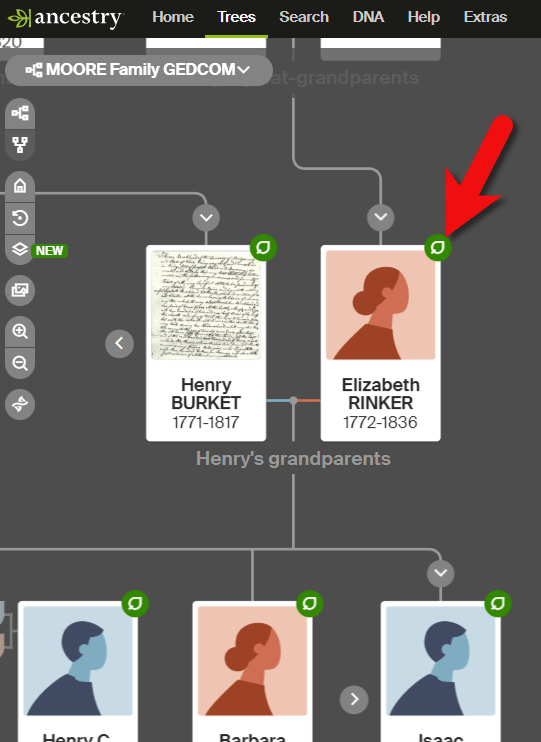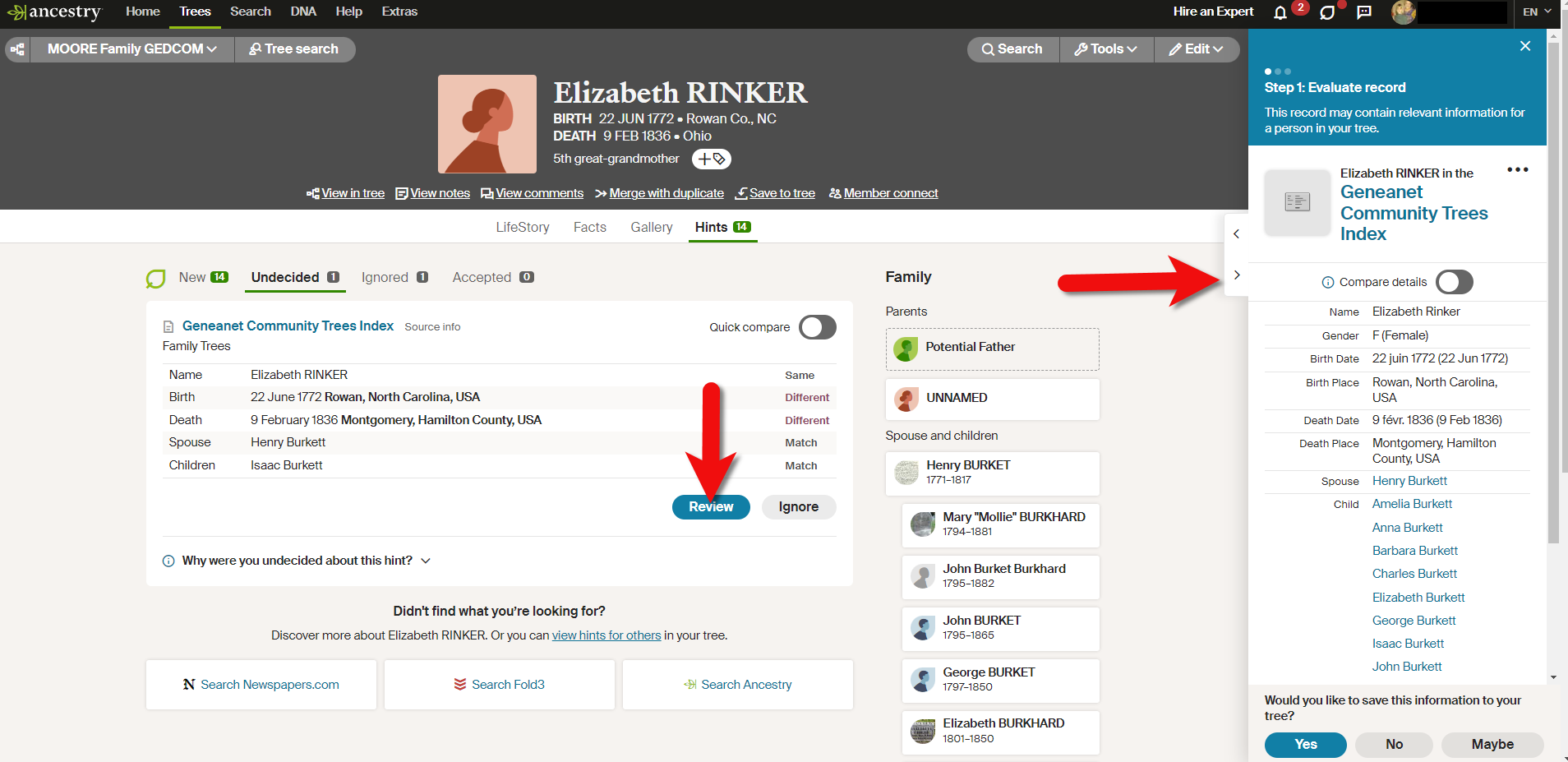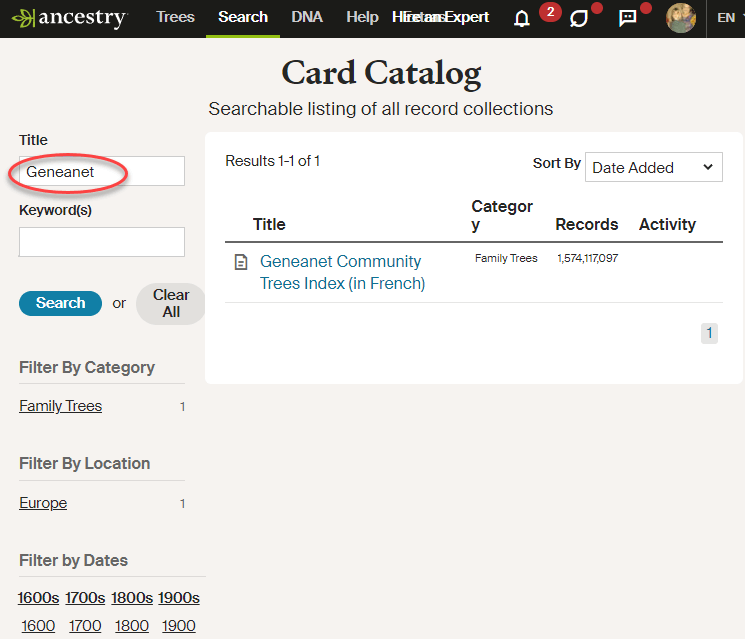Show Notes: Have you seen records from Geneanet popping up in your Ancestry hints? Here’s the answer to a Premium Member’s questions about the Geneanet records she is seeing show up as Ancestry hints. Learn how to figure out what new record hints like this are and how to decide how much weight to give them.
Show Notes
Downloadable ad-free Show Notes handout (Premium Membership required. Learn more or become a member.)
I received the following question from Monete, a Premium Member: What is this new thing I’m seeing on Ancestry hints, Geneanet community trees? It’s a good question, and a common one. Genealogy websites like Ancestry are adding new record collections all the time. It’s important to know how to quickly understand what the new record collection is about, where it comes from, the scope and most importantly, decide how much weight to give it.
Records Included in Ancestry Hints
It’s important to note that not all records are included in Ancestry hints. Only 10% of Ancestry® records appear as hints. So we want to keep in mind that although we’re seeing lots of new hints for records, they aren’t by any stretch of the imagination all of the records in the Ancestry collection. Hints are made up of the most popular record collections. There’s always going to be a need to continue to do your own research and to explore other records.
Where to find Ancestry Hints
You’ll find hints in a variety of places such as:
- the leaf icon at the top of the screen near your account profile
- attached to ancestors in your family tree
- on ancestor profile pages

Ancestry hint in family tree
Reviewing and Comparing Ancestry Hint Information
View the hint by clicking the Review button. In the case of hints from the Geneanet Community Trees Index, you’ll see the pop-out panel prompting you to evaluate the record.

Click the Review button to reveal the side panel.
Compare the details of the hint to the known details in your ancestor’s profile by clicking the Compare Details slider button. This allows you to review and compare each piece of information.
In a case like this where we are unfamiliar with the record collection, it’s important to learn more about it before we compare and make decisions about the information. That way, as you evaluate each piece of information you are considering adding to your family tree, you will have a much better idea whether you trust the source, and you’ll be better able to interpret the information it is providing.
To learn more about the record, it’s a logical next step to click the hyperlinked record name at the top of the panel. However, in this case we notice it just brings up to a full-size page where we are again being prompted to review and add the information to our tree.
Use the Ancestry Card Catalog
When you run across something like this, the first thing to keep in mind is that this record collection they are referencing is obviously part of their total collection, which means we should be able to find it in the card catalog. That’s the best place on Ancestry to learn more about it. Copy the name of the record and then go the Card Catalog. You’ll find the Card Catalog in the menu under Search > Card Catalog. It can be helpful to access the Card Catalog in a new browser tab so that you can jump back and forth between the catalog entry and the record you’re reviewing. You can open it in a new tab by right-clicking on Card Catalog when selecting it from the Search menu.
The card catalog is something that we don’t think of using that often. But really, we should because this is where all the other records are that are not coming up in our hints are listed. It’s also a really terrific resource to tell us more about the record collections that we’re running into as we’re doing our research and evaluating our hints.
On the Card Catalog page, paste the name of the record collection that you copied in the Title search box. If for any reason it doesn’t come up right away, try typing just the keywords into either the Title box or the Keywords search box.
You should see the collection in the search result. When you hover over the collection title it tells you when it was published, if it was recently updated, and the beginning sentences of the collection description. You will see what type of record it is by the category in which Ancestry placed it, and get a sense of the size of the collection.

Searching the name of the record collection in the Ancestry Card Catalog
In the case of Geneanet, the category is family trees. So, without knowing anything more about it, we would expect this is probably user-contributed information, rather than, let’s say, a census record created by the government, or a birth record recorded by a pastor in a church. These family trees were created by many other genealogists. They may or may not include source citations or even be accurate.
Let’s learn even more about the collection. Click the title of the record collection. The next page will feature search fields and related records. Skip that for now and scroll down to the bottom of the page. This is where you really get to the heart of things about the collection. First you’ll see Source Information. Basically, this is saying Ancestry is the source (that’s where you found the hint) and Ancestry got it from Geneanet.
Next you’ll see the About section. This will help us determine the original purpose of the collection, how it was created, and so on. The About section tells us that this is an online database. And it tells the original data came from the Geneanet Community Trees Index in Paris, France.
Next you’ll find Using this Collection which provides an overview of the kind of information you can expect to find in the records. Next is Collection in Context. This explains “Geneanet was created in 1996 as a way to connect genealogical resources. They use a unique, collaborative model to share family resources while building community. Genealogists, both amateur and professional, are connected with users and genealogical societies. Anyone may upload content.”
“Anyone may upload content” is the key phrase here. People add information to family trees for a variety of reasons. Sometimes they are just testing out a theory and they aren’t even sure it’s accurate. And many people copy and paste information from other people’s trees. All of this means that we can only use this information as clues, not as facts. We must do our own research and homework to find the records that back up the assertions made in the record. Family tree records if used unwisely could easily introduce errors into your family tree.
Finally, in the About section we find the Bibliography which includes a clickable link over to the original sources for these records: Geneanet. Take a moment to visit the site. You can also learn more by some quick googling. Typically, companies like this are going to be listed on Wikipedia pages as well. That’s a that’s a good place to get a basic summary about when was this company founded, find out when it was purchased by the big genealogy website, if it is currently active, and the main website link. All that kind of stuff we can typically find over in the right-hand kind of summary column on the Wikipedia page.
Using and Managing Ancestry Hints
Hints can be great clues, but they can also put rabbit holes in your genealogical path and derail your research goals. This hint might not be your top priority right now. It might not be the most important aspect of your ancestor’s life. Or it might be super interesting, and in that case you can go for it. But I encourage you not to get addicted to just responding to hints. It’s OK to put it on the back burner, leave the hint and don’t even deal with it. You can mark it Maybe and then come back to it later. But don’t let it sidetrack you from your research goals.
That’s the thing about genealogy. It is becoming more and more automated. Have you found that it just feels like it’s happening more and more on its own? It’s sort of being fed to us through the automation, the machine learning, that’s happening on these websites. However, first and foremost, we need to keep our brains engaged. We need to be the one who does the evaluation and ultimately makes the decision as to what we think is accurate about our ancestor and our family history.
In the case of Geneanet, Wikipedia tells us it was created in France and ultimately was acquired by Ancestry in August 2021. We saw on the Card Catalog entry that the index was published on Ancestry in 2022. So, we are looking at information coming from an index. We’re not looking at the actual record. These records are housed on the Geneanet website. You can access the actual record by clicking the View on Geneanet link on the Ancestry record hint page
Resources:
- Downloadable ad-free Show Notes handout (Premium Membership required. Learn more or become a member.)
- Ancestry Top Tips and Hot Keys (video and show notes) Premium content
- Provenance: The Story Behind Your Genealogy Records (video and show notes)
- Source Citations for Genealogy (video and show notes)

Click to learn more about Genealogy Gems Premium Membership.

I’ll be working but will watch replay
Thank you so much for this excellent information and advice!
You’re so welcome, thank you!